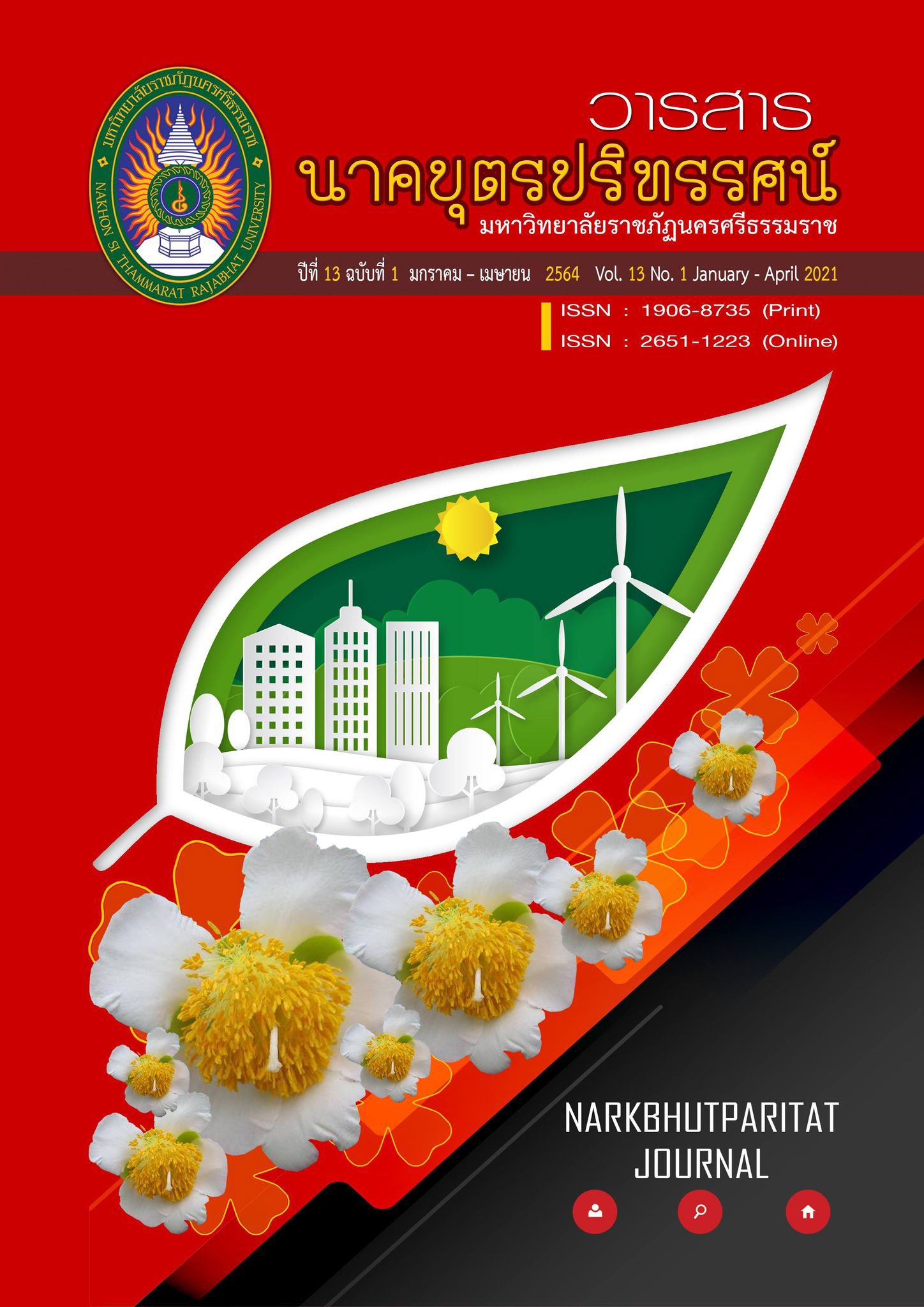ผลของการจัดการเรียนรู้โดยใช้กลวิธี STAR ร่วมกับเทคนิคคู่คิด ที่มีต่อความสามารถในการแก้ปัญหาทางคณิตศาสตร์และความสามารถในการสื่อสารทางคณิตศาสตร์ของนักเรียน ชั้นประถมศึกษาปีที่ 2
Main Article Content
บทคัดย่อ
การวิจัยครั้งนี้มีวัตถุประสงค์เพื่อเปรียบเทียบความสามารถในการแก้ปัญหาและความสามารถในการสื่อสารทางคณิตศาสตร์ของนักเรียนชั้นประถมศึกษาปีที่ 2 หลังได้รับการจัดการเรียนรู้โดยใช้กลวิธี STAR ร่วมกับเทคนิคคู่คิดกับเกณฑ์ร้อยละ 70 กลุ่มตัวอย่างที่ใช้ในการวิจัยครั้งนี้ ได้แก่ นักเรียนชั้นประถมศึกษาปีที่ 2/2 ภาคเรียนที่ 2 ปีการศึกษา 2561 โรงเรียนบ้านสวนอุดมวิทยา จำนวน 31 คน ซึ่งได้มาจากการสุ่มตัวอย่างแบบกลุ่ม เครื่องมือที่ใช้ในการทำวิจัย คือ 1) แผนการจัดกิจกรรมการเรียนรู้คณิตศาสตร์โดยใช้กลวิธี STAR ร่วมกับเทคนิคคู่คิด จำนวน 6 แผน 2) แบบวัดความสามารถในการแก้ปัญหาทางคณิตศาสตร์และความสามารถในการสื่อสารทางคณิตศาสตร์ด้านการเขียน ที่มีค่าความเชื่อมั่นเท่ากับ .79 3) แบบสังเกตความสามารถในการสื่อสารทางคณิตศาสตร์ด้านการพูด สถิติที่ใช้ในการวิเคราะห์ข้อมูล ได้แก่ ค่าเฉลี่ยเลขคณิต ( ) ส่วนเบี่ยงเบนมาตรฐาน (S.D.) และการทดสอบที แบบกลุ่มตัวอย่างเดียว ซึ่งผลการวิจัยสรุปได้ ดังนี้
- ความสามารถในการแก้ปัญหาทางคณิตศาสตร์ของนักเรียนชั้นประถมศึกษาปีที่ 2 ที่ได้รับการจัดกิจกรรมการเรียนรู้คณิตศาสตร์โดยใช้กลวิธี STAR ร่วมกับเทคนิคคู่คิดสูงกว่าเกณฑ์ ร้อยละ 70 อย่างมีนัยสำคัญทางสถิติที่ระดับ .05
- ความสามารถในการสื่อสารทางคณิตศาสตร์ของนักเรียนชั้นประถมศึกษาปีที่ 2 ที่ได้รับการจัดกิจกรรมการเรียนรู้คณิตศาสตร์โดยใช้กลวิธี STAR ร่วมกับเทคนิคคู่คิดสูงกว่าเกณฑ์ร้อยละ 70 อย่างมีนัยสำคัญทางสถิติที่ระดับ .05
Article Details
References
Academic Department. (2002A). Learner-centered learning management techniques are the most important cooperative learning management. Bangkok: Religion Printing House. (in Thai)
Barragato, A. (2015). Think/Pair/Share and Variations, An Effective Implementation Guide for Active Learning and Assessment. U.S.A: Michigan University.
Makanong, A. (2010). Mathematical skills and processes: development for development. Bangkok: Faculty of Education and Social Sciences Chulalongkorn University. (in Thai)
Srisa-ard, B. (1994). Teaching development. Bangkok: Suveeriyasan. (in Thai)
Dales, Z. I. (2007). Achievement of Students in Mathematics Using the Think-Pair-Share Strategy. Dissertation Abstracts International. Retrieved 2016, May 9, from http://www.bsc.edu.ph/index.php/reserch/abstracts
Gagnon, J. C., and Krezmien, M. (2011). Effective instructional strategies for correctional education programs. Retrieved 2016, April 5, from http://www.edjj.org/conf/ cdEDJJ%20 Conference%20(D)/Effecttive%20Instruction.ppt
Instructional Strategy Lessons for Educators Secondary Education (ISLES-S). (2014). GROUPING: Think-Pair-Share Jigsaw. U.S.A: East Carolina University.
Karnjanarakphong, S. (2004). 29 Techniques for organizing various learning activities: cooperative learning. Bangkok: Thanakson Publishing. (in Thai)
Ledlow, S. (2001). Using Think-Pair-Share in the College Classroom. Retrieved 2016, April 6, from https://kaneb.nd.edu/assets/137953/think_pair_share_tips.pdf
Lyman, F. T. (1981). The Responsive Classroom Discussion: The Inclusion of all Students. In: A. Anderson (Ed.), Mainstreaming Digest. pp. 109-113. College Park: University of Maryland Press.
Maccini, P. (1998). Effects of an instructional strategy incorporating concrete problem representation on the introductory algebra performance of secondary students with learning disabilities. Unpublished doctoral dissertation, The Pennsylvania State University, University Park.
Maccini, P., and Hughes, C. A. (2000). Effects of a problem solving strategy on the introductory algebra performance of secondary students with learning disabilities. Learning disabilities research & practice, 15(1), 10-21.
Maccini, P., and Gagnon, J. (2011). Mathematics strategy instruction (SI) for middle school students with learning disabilities. Retrieved 2016, April 6, from http://www.k8a ccesscenter.org/training_resources/massini.asp
National Council of Teachers of Mathematics NCTM, (2000). Principles and Standards for School Mathematics. Va: Author.
National Test. (2017). Report of the National Student Fundamental Ability Test (National Test: NT). Retrieved 2017, September 29, from http://bet.obec.go.th/ index/ (in Thai)
Office of the Education Council Secretariat. (2013). Measure of Achievement Report. Bangkok. Author. (in Thai)
Robertson, K. (2015). Increase Student Interaction with "Think-Pair-Shares" and "Circle Chats". Retrieved 2011, April 29, from http://www.colorincolorado.org/article/ increase-student-interaction-think-pair-shares-and-circle-chats.
Moonkhum, S. and Moonkhum, A. (2002). 19 Methods of learning management: To develop knowledge and skills. Bangkok: pabpim. (in Thai)
Khotrakoon, S. (2005). Educational psychology. (6th ed). Bangkok: Publishing House of Chulalongkorn University.
Tangsriseree, S. (2013) .The results of the learning activities using teaching methods found by guiding and techniques. THINK-PAIR-SHARE Towards communication abilities and ability to connect mathematical knowledge of Mathayomsuksa 2 students. (Master of Education Thesis). Chulalongkorn University, Graduate School. Mathematics Education.
Piphitthakun, Y. (1996). Teaching and learning mathematics. Bangkok: Bophit Printing. (in Thai)
Sangseebab, P. (2013) Results of collaborative learning management using the STAR strategy on problem solving (Master of Education Thesis). Srinakharinwirot University, Academic field of secondary education. (in Thai)
Linear equations, single variables and variations On problem solving ability And mathematical associative skills Of Mathayom Suksa 2 students.
Suksriwattana, J., and Suwannachot, T. (2018). Lecturer of Mathematics Learning Group. Interview, 8 October 2018. (in Thai)
The Institute for the Promotion of Teaching Science and Technology (IPST). (2008).
Skills/process mathematics. Bankok: S.Charoen. (in Thai)

